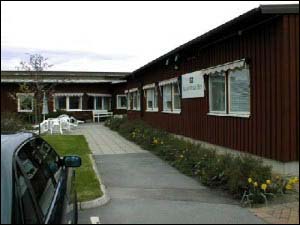Campus Valla, Linköping
Campus Valla, Linköping

Akademiska Hu's site office is located in the middle of Campus Valla in Linköping.
Generally
In order to obtain good air quality in the premises, the ventilation is adapted to the number of people and the equipment planned for the rooms. To provide heat and prevent frostbite, there are radiators located along facade walls.
Office
The air supply in offices takes place automatically with a continuous flow.
Meeting room
In meeting rooms, the ventilation can be forced manually via a push button on the wall. The air flow then increases during the set time. This function is possible during regular office hours.
Conference room
In the conference room and its foyer, the normal temperature can be slightly influenced via a room regulator inside the door. If the switch is turned to plus, it will be warmer and if it is turned to minus, it will be colder.
Extended operating time
After regular office hours, i.e. in the evening and on weekends, the ventilation in the building is switched off to save energy.
Car parking
Parking spaces intended for vehicles with a handicap permit are available.
Entrances and lifts
The entrances are accessible and all floors can be reached via lift
RWC and rest room
Toilets adapted for the disabled are available on floor 2. In rest rooms and at the RWC there are security alarms with red push buttons labeled "emergency signal". Alarms are indicated locally by sound and a red flashing light outside each room. It is important that you who see and hear this alarm contact the person concerned who needs help. The security alarm is forwarded to reception during the day. Alarms are reset inside each room by pressing the reset button.
SCARED - WARN - ALARM - EXTINGUISH
• save yourself and others around you, but don't take too many risks yourself
• warn others who may be in danger
• alert the Emergency Services by calling 112
• put out the fire if possible
Automatic fire alarm
Evacuation alarms in case of fire are triggered via smoke detectors placed in escape routes, technical spaces and in spaces where many people gather. Triggered alarm, i.e. signal to evacuate, given via doorbell Triggered alarm goes to Akademiska Hus and security guards. Fires that cannot be extinguished with deployed hand fire extinguishers must be alerted via telephone 112. Limit the source of the fire by closing windows and doors.
You can manually trigger the evacuation alarm using push buttons in connection with the escape routes.
Fire cells
The building is divided into a number of fire cells to prevent fire and smoke from spreading.
Each fire cell is delimited by fire-rated walls and doors. In principle, all floors, stairwells, lifts, operating areas and waste rooms have their own fire cells. Doors in fire cell boundaries can be magnetically suspended in the open position for transport and closed manually with a push button marked "fire door closer". When an evacuation alarm is triggered, the doors close automatically within the alarmed area.
Doors in fire compartment boundaries must absolutely not be blocked by wedges or the like!
Escape routes / Assembly point
See evacuation plans in corridors.
The stairwells form independent escape routes. Two stairwells can be reached from each workplace. The escape routes, which are marked with green luminous escape signs, must never be blocked. The green signs are always lit and have a battery backup to illuminate even in the event of a power cut.
If the fire alarm is triggered, all personnel must leave the building, close all doors behind them and gather at the assembly point (See the respective evacuation plan). The staff reports there to the evacuation recipient and leaves their name and group affiliation or equivalent. No one may depart from the assembly point until this is done.
Public areas
In stairwells, the lighting is controlled automatically via presence. In corridors, the lighting is controlled automatically via presence. Some lighting is switched on after regular office hours, so-called led lighting. In the WC and store room, the lighting is switched on and off automatically via presence detectors.
Office
In offices, the lighting is controlled automatically via presence detectors. In some larger rooms, the lighting is turned on and off manually via a push button inside the door. Presence detectors turn off the lighting if no one has been in the room for a certain period of time. The office lighting has daylight regulation, which means that switched on lighting is regulated according to incident daylight.
Pull switch office
To switch off or dim individual ceiling luminaires, the pull switch on the luminaire is used. Turn on and off with two short pulls and adjust the light with a long pull.
Conference and meeting rooms
In conference and meeting rooms, there is a push button panel that regulates lighting and switches the lighting on/off
AV equipment
For questions regarding AV equipment, contact staff in the building
In the garage and reception of goods in the backyard, waste is sorted into the following fractions:
- Metal
- Batteries
- Soft plastic
- Cellulose plastic
- Cardboard and corrugated cardboard
- Fluorescent tubes, mercury and light bulbs
- Electronics, data
Office paper, newspapers and magazines are sorted locally in the house.